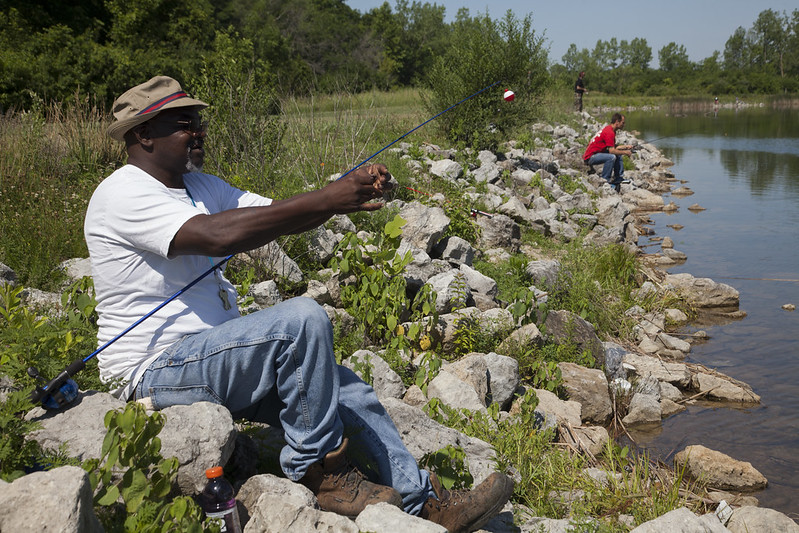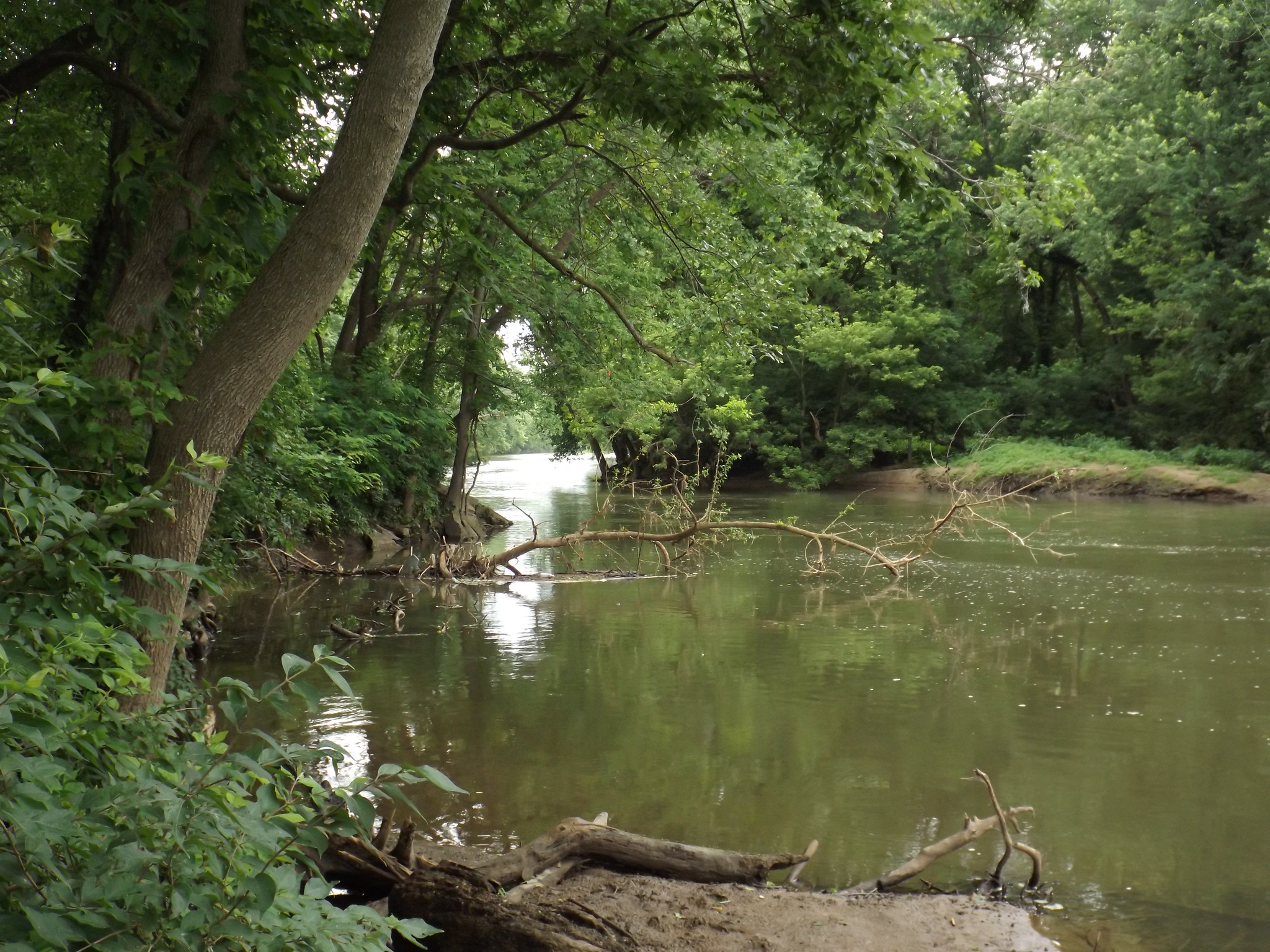Published June 10, 2020
Tour the trees in your MetroParks this summer
Heads up! This article was published 4 years ago.
A conservation agency, Five Rivers MetroParks protects nearly 16,000 acres of land – 90% of it in its natural state, meaning it is protected from development. This creates a treasure trove of natural points-of-interest in MetroParks, especially large, impressive trees that were standing long before Five Rivers MetroParks existed as agency.
This summer, hit the trails and take a big tree tour in your MetroParks.
ENGLEWOOD METROPARK (West Park), 100 E. National Rd., Englewood
Big Blue: Many of the trees in the forested areas Five Rivers MetroParks protects have been around much longer than even the state of Ohio! Imagine all the changes these old trees have seen. You’ll find Big Blue, a champion blue ash tree, just past the stone gate entrance to the West Park area.
ISLAND METROPARK, 101 E. Helena St., Dayton
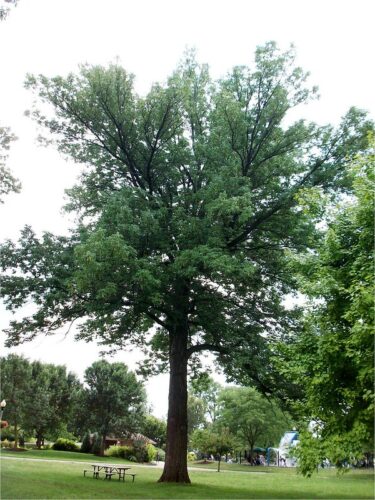
Ashzilla: Did you know that a mature, leafy tree produces as much oxygen in a season as 10 people inhale in a year? Trees also filter the air by intercepting airborne particles, reducing heat and absorbing such pollutants as carbon monoxide, sulfur dioxide and nitrogen dioxide. Check out one of the biggest trees in MetroParks: “Ashzilla,” a white ash tree close to the parking lot at Island MetroPark, just east of the small brown building.
SUGARCREEK METROPARK, 4178 Conference Rd., Bellbrook
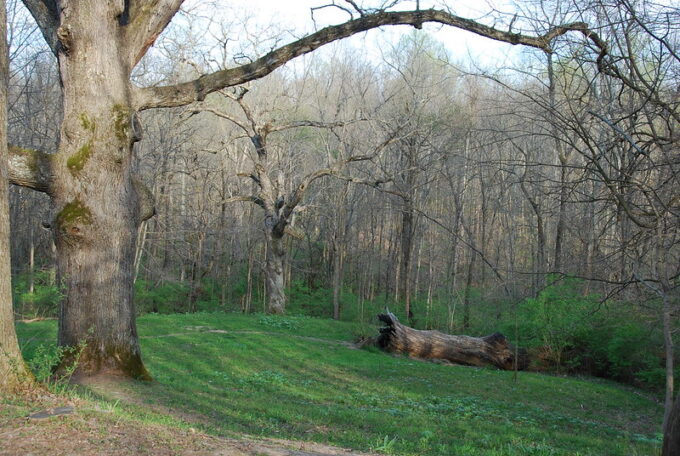
Three Sisters: What do 550-year-old trees look like? Find out when you venture 0.7 miles along the Orange Trail to the site of the “Three Sisters,” three ancient white oak trees.
These now-giant white oak trees have been part of the woodland for 550 years. Most of the land in Sugarcreek MetroPark once was farmland. However, as early European settlers cleared the land, for reasons unknown these trees were spared.
Although in decline, two trees still stand. In summer 2008, one of the Three Sisters fell down, as it had been declining due to a fire that had burned it on the inside and part of hte outside when it was struck by lightning years earlier.
Borings from the trunk, done in the late 1960s on the largest of the three, indicate they began growing around 1440. What else was happening in the world then?
- The Little Ice Age, a period between about 1300 and 1870 during which North America and Europe were subjected to much colder winters, was underway.
- German man Johannes Gutenberg invented the printing press.
- The Renaissance, which lasted from the 14th to the 17th centuries and is considered the bridge between the Middle Ages and modern history, was well underway in Europe.
- The Inca Empire, the largest empire in pre-Columbian America, was expanding quickly and eventually incorporated a large portion of western South American until it was conquered by the Spanish in 1572.
The Three Sisters have outlived extreme cold and drought, an invention that led to many other trees being cut down, philosophical ages and kingdoms. The trees pre-date by centuries the city of Dayton — which was founded on April 1, 1796, by a group of 12 settlers known as The Thompson Party — and the state of Ohio, which became the 17th state in the Union on March 1, 1803. Only time will tell how much longer they will stand.
The largest of the three trees, dubbed the Big Sister, is one of the two largest trees in MetroParks, with a circumference of 226 inches, a height of 141 feet and a crown spread of 93 feet – almost as tall as the Arc de Triomphe.
Beech Woods: The native vegetation of the Sugarcreek area consisted of beech woods, mixed oak, sugar maple, elm and ash swamps along the creeks and flood plains. The park still contains several remnant beech from the native forest. Mature beech trees from that forest, some measuring up to 35 inches in diameter and probably 200 years old, are found in the east end of the park.
Sycamore Ridge: The sycamore is usually a tree of floodplains, stream-sides and moist banks. Here, however, sycamores are growing on a ridge. This suggests that a water source seeps beneath this ridge and provides the sycamores with adequate moisture. To recognize a sycamore, look for a tree with white bark on the upper portions.
Sycamore Ridge is a good example of an esker, a long ridge of gravel and other sediment, typically having a winding course, deposited by meltwater from a retreating glacier or ice sheet.
Sycamore’s large leaves make this an excellent shade tree. Finding the largest sycamore leaf on the ground is a great activity for kids. Green leaves are munched on by the caterpillar of tiger swallowtail butterflies, as well as about 37 other species of months and butterflies, which in turn are excellent food sources for birds – making sycamores an important part of the food chain.
Sycamore trees tend to become hollow over time, which is caused by a fungus that rarely results in serious damage to the tree. Rather, wildlife often use these hollow trees for shelter. This is just one more reason sycamore are an important part of a healthy forest in Montgomery County.
Other great places to find sycamores are:
- By the lagoon at Eastwood MetroPark
- Germantown MetroPark’s old forest (orange trail)
- Woodman Fen Conservation Area (boardwalk trail)
WEGERZYN GARDENS METROPARK, 1301 E. Siebenthaler Ave., Dayton
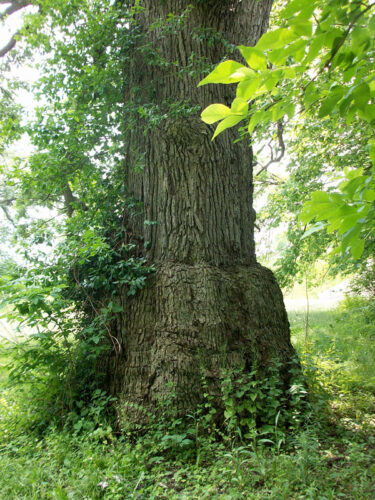
Giant Pedestal Oak: Find one of Five Rivers MetroParks’ biggest trees along the trail between the parking lot and gate entrance. It is named “Pedestal Oak” because it appears to sit on a large base.
This oak survived the 2019 Memorial Day tornadoes, but another oak near by did not. Stand next to the giant standing oak and then the downed oak to get an idea of just how big these impressive trees are.
DULL WOODS CONSERVATION AREA: Accessible from the Wolf Creek Trail
Ralph’s Oak: This massive Shumard Oak tree (Quercus shumardii) is the fourth largest tree in the MetroParks system. It’s named after Ralph Dull, a well-known conservationist and farmer who leased the woods to MetroParks in 2003. Dull recognized the value of this beautiful natural area and was willing to share this piece of the local heritage with the public. The oak is visible from the boardwalk.
Five Rivers MetroParks visitors should always follow the CDC’s recommendations while spending time outdoors. For the most current information on MetroParks’ COVID-19 response and related closures, visit metroparks.org/covid-19 and follow Five Rivers MetroParks on Facebook, Twitter and Instagram.
Biggest Trees in MetroParks
- Big Sister (white oak): Sugarcreek MetroPark
- Bea’s Tree (cottonwood): Englewood MetroPark
- Ralph’s Oak (shumard oak): Dull Woods Conservation Area
- Pedestal Oak (bur oak): Wegerzyn Gardens MetroPark
- Champion Oak (shumard oak): Taylorsville MetroPark – this tree was damaged in a storm several years ago and is declining
Five Rivers MetroParks visitors should always follow the CDC’s recommendations while spending time outdoors. For the most current information on MetroParks’ COVID-19 response and related closures, visit metroparks.org/covid-19 and follow Five Rivers MetroParks on Facebook, Twitter and Instagram.



